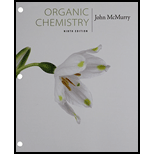
a) LiAlH4, then H3O+
Interpretation:
The product produced when p-methylbenzoic acid is treated with LiAlH4 and then with H3O+ is to be predicted.
Concept introduction:
To predict:
The product produced when p-methylbenzoic acid is treated with LiAlH4 and then with H3O+.
b) N-Bromosuccinimide in CCl4
Interpretation:
The product produced when p-methylbenzoic acid is treated with N-bromosuccinimide in CCl4 is to be predicted.
Concept introduction:
N-bromosuccinimide in CCl4 is used for introducing a Br in the benzyl carbon.
To predict:
The product produced when p-methylbenzoic acid is treated with N-bromosuccinimide in CCl4.
c) CH3MgBr in ether, then H3O+
Interpretation:
The product produced when p-methylbenzoic acid is treated with CH3MgBr and then with H3O+ is to be predicted.
Concept introduction:
Grignard reagents will react with the carboxyl hydrogen to yield
To predict:
The product produced when p-methylbenzoic acid is treated with CH3MgBr and then with H3O+.
d) KMnO4, H3O+
Interpretation:
The product produced when p-methylbenzoic acid is treated with KMnO4 in the presence of H3O+ is to be predicted.
Concept introduction:
When treated with KMnO4 in the presence of H3O+, the side chain in
To predict:
The product produced when p-methylbenzoic acid is treated with KMnO4 in the presence of H3O+.
Trending nowThis is a popular solution!

Chapter 20 Solutions
Bundle: Organic Chemistry, Loose-leaf Version, 9th + LMS Integrated for OWLv2, 4 terms (24 months) Printed Access Card
- Draw the structures of the following.arrow_forward(a) Write the structures of main products when aniline reacts with the following reagents :(i) Br2 water (ii) HCI (iii) (CH3CO)2O/pyridine(b) Arrange the following in the increasing order of their boiling point :C2H5NH2, C2H5OH, (CH3)3N(c) Give a simple chemical test to distinguish between the following pair of compounds : (CH3)2NH and (CH3)3Narrow_forwardPredict the products of the following reactions:arrow_forward
- (a) Suggest a synthesis for the following molecules starting with benzene and any other necessary reagents. (i) H2N CI (ii) OH CN 6.arrow_forward(a) How will you convert the following :(i) Propanone to Propan-2-ol (ii) Ethanal to 2-hydroxy propanoic acid(iii) Toluene to benzoic acid(b) Give simple chemical test to distinguish between :(i) Pentan-2-one and Pentan-3-one (ii) Ethanal and Propanalarrow_forwardWrite a balanced chemical equation for each of the following reactions: (a) Phenol + sodium hydroxide (b) Product of part (a) + ethyl bromide (c) Product of part (a) + butyl p-toluenesulfonate (d) Product of part (a) + acetic anhydride (e) o-Cresol + benzoyl chloride (f) m-Cresol + ethylene oxide (g) 2,6-Dichlorophenol + bromine (h) p-Cresol + excess aqueous bromine (i) Isopropyl phenyl ether + excess hydrogen bromide + heatarrow_forward
- Predict the products of the reaction of the following substances with CrO3 in aqueous acid:arrow_forward(a) Draw the structures of the following compounds :(i) 4-Chloropentan-2-one (ii) p-Nitropropiophenone(b) Give tests to distinguish between the following pairs of compounds :(i) Ethanal and Propanal (ii) Phenol and Benzoic acid(iii) Benzaldehyde and Acetophenonearrow_forward6) If you are given a mixture consisting of following 3 compounds, explain how you would separate the components by solvent extraction method NH2 ÇOOH (A) Cyclopentylamine (B) 2,4-Cyclopentadiene-1-carboxylic acid (C) Benzenearrow_forward
 Organic ChemistryChemistryISBN:9781305580350Author:William H. Brown, Brent L. Iverson, Eric Anslyn, Christopher S. FootePublisher:Cengage Learning
Organic ChemistryChemistryISBN:9781305580350Author:William H. Brown, Brent L. Iverson, Eric Anslyn, Christopher S. FootePublisher:Cengage Learning

